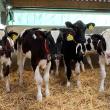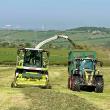Advanced Robot’s experience means they are always challenging me to get the best out of the cows, they maintain the herd’s health status whilst also improving performance.
Celebrating Dairy Innovation at The Cream Awards
Advanced Ruminant Nutrition give us the low down on the Most Efficient AMS Award. First Published in British Dairying.

In partnership with the Cream Awards, Advanced Ruminant Nutrition proudly unveiled a brand-new category for the 2024 ceremony – the “Most Efficient AMS System” award. The award represents a significant milestone in recognising the transformative impact of robotic milking systems in modern dairy farming. As the dairy industry evolves, technology becomes an essential driver of efficiency, sustainability, and farm profitability. Technical Director Eoghan Mullery comments, “The aim of the award was to put pioneering farmers, who have successfully harnessed automation to improve the efficiency of their operations, into the spotlight.” “Our dedication to supporting dairy farmers on their robotic journey is a huge part of our business, “explains Eoghan.
“We’ve worked in all types of AMS systems for over a decade and our Advanced Robot division provides farmers with tailored solutions. By balancing nutrition, health, and management with optimised robot settings, we help farmers maximise the return on their investment. Naturally installing robots means the farm is starting with higher fixed costs, so improving efficiency is a large part of helping to increase margins.”
WHAT WE LOOKED FOR IN THE AWARD ENTRIES
“The award was designed to evaluate the complete spectrum of systems used by farmers, from high-input, high-output operations to more moderate, lower-input lower-output approaches. We looked for entries that demonstrated clear goals, sustainable practices, and efficient use of resources. Efficiency isn’t simply about maximising yield; we were looking for a farm that was about making the most out of the chosen system to achieve farm-specific objectives. For example, enhancing cow health, improving milk quality, reducing environmental impact, increasing labour efficiency.” “Key performance indicators (KPIs), like margin over feed costs, milk solids per cow per day, and transition cow management played an important role in our evaluation. We also assessed how entrants balanced technology with cow well-being, reproduction rates, and overall farm sustainability.” “We were particularly impressed by the diversity of approaches, with entrants showcasing a range of feeding systems and forage types. From grazing-based systems to fully housed setups, each entry provided a unique insight into how robotic milking can be adapted to suit different farm environments and goals. Whilst this year’s winners were high output systems, they really ticked all the boxes in terms of making the best use of the technology to achieve their own KPI’s.”
RECOGNISING OUR WINNERS
“This year’s winners – Craig and Robert Sloan of Shawsmuir Farm, Kate and Tom Nicholls of Acland Farm, and Joe Ives W&P Ives – stood out by demonstrating exceptional efficiency in their systems, despite utilising different approaches. Each farm showcased impressive performance metrics, whether it was through maximising milk production per robot, achieving optimal milk solids, or ensuring high levels of cow health and reproduction.” “What set these winners apart was their clear understanding of how to optimise transition cow management, a key factor in fresh cow performance and overall herd productivity. They all excelled in balancing cow health and reproduction while optimising milk output, a critical component for AMS success. Additionally, heifer performance, a reliable KPI for AMS farms, highlighted the winners’ ability to nurture the next generation of productive cows. They all looked towards future sustainability, and considered working patterns for the next generation, ” explains Eoghan. Geographically, the entries represented a wide spectrum of the UK’s diverse dairy landscape, from the Northeast of Scotland to Southwest England. This variety reflects the adaptability of AMS technology across different climates, forage bases, and farm sizes.
NEXT YEARS AWARDS
While this year’s winners were high output systems, the “Most Efficient AMS System” award is open to all types of systems and farms, regardless of size or output level. We encourage more farmers, particularly those with lower input systems or those newer to robotics, to enter next year. Efficiency isn’t just about high output; it’s about setting clear objectives, working towards them, and demonstrating sustainable use of technology.
Eoghan adds, “It was great to see entries from a wide variety of systems this year and whilst the winners were from a high output system, that wasn’t the reason for winning - they just ticked all the boxes - which pointed to exceptional efficiency.
“We’d encourage anyone who’s passionate about their robotic system, has really tried to align to their own set of KPIs to improve efficiency, to enter the award next year.” We can’t wait to see what the future holds and look forward to visiting even more innovative robot farms in 2025!
〈 BACK




